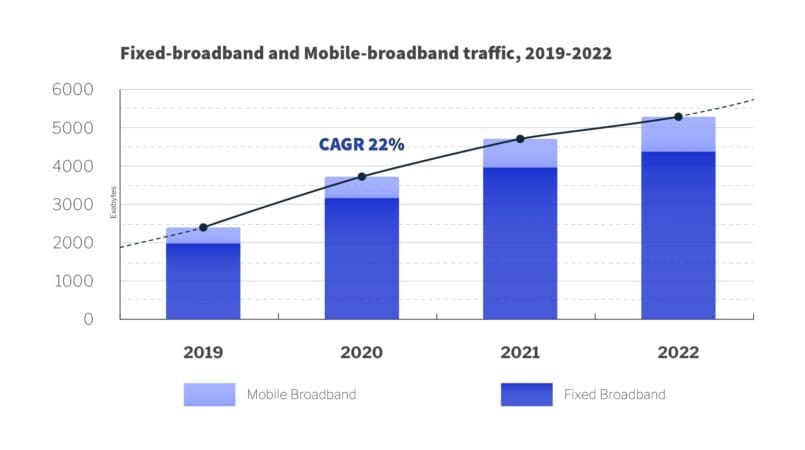
Global Internet traffic growth forecast: Looking forward from 2024
Recent History:
According to ITU data – until now, worldwide global Internet traffic has grown at an average annual rate of 22%, increasing from 2401 Exabytes in 2019 to 5291 Exabytes in 2022. The overall growth rate is impressive, but there are some quite expected, but also some interesting findings that may be uncovered, if you dive further into the data. For instance:
- As expected – internet traffic growth rate is slower in developed western world – in Europe CAGR for same period is 18%, in America 16%. For contrast, the Arab nations have the highest growth rate (2019-2022 CAGR 34%), followed by Africa (2019-2022 CAGR 31%) and the Asia-Pacific region (2019-2022 CAGR 25%). This is hardly surprising given that the Western world has already achieved saturation levels for both mobile devices and fixed data connections, but the number of new customers in the rest of the globe is just now increasing quickly. This gives us confidence that soon, the digital divide will shrink and we will be closer to the global village.
- Interesting – that mobile broadband traffic comprises a mere 17% of the overall global Internet traffic, and this percentage remains constant despite the expansion of mobile broadband usage. Intuitively, this proportion should increase as we spend an increasing amount of time on mobile devices and consume content of higher quality. Nevertheless, it has been determined that fixed broadband continues to be the preferred option for heavy Internet data users. Despite the frequent use of mobile devices, they are typically offloaded via fixed broadband when accessing WiFi in public areas, workplaces, or homes.
- As expected – Video traffic accounts for the majority of overall global Internet traffic. What’s striking is that in 2022, video traffic accounted for 65% of total global Internet traffic, with a 24% increase over the previous year. In 2022, the Netflix application surpassed YouTube in terms of produced traffic, accounting for 15% of all Internet traffic. TikTok, Disney+, and Hulu are the next three most traffic generating apps. Why has the amount of video consumption increased so significantly? – Video is essential for conferencing, gaming, social networking, and messaging. People are spending more and more time on their gadgets, and the quality of video content is improving
- Interesting – COVID 19 (we hope) is a once-in-a-lifetime occurrence – this was the largest epidemic since the Spanish flu that raged in 1918/19. Network operators faced a major challenge in adapting their networks to sudden shift in user behavior. Due to the lockdown, people began working from home. Livestreaming applications saw the most rapid growth (who had heard of Zoom before the pandemic?) for both business as well as contact with family and friends. That was followed by significantly higher video consumption on popular streaming services, as well as a huge rise in messenger usage. All these changes produced unprecedented traffic peaks, raising worries about network stability. It must be noted that, in the end, Western operators dealt with this quick shift in user habits reasonably calmly, whereas India, sections of Sub-Saharan Africa, and South America experienced signs of network stress. The epidemic ended, but user behaviors persisted: in the post-pandemic period, substantially more video content is consumed, livestreaming programs are utilized, and work from home is new normal.
Future anticipations:
Predicting the future in such a technologically fast-moving and constantly changing sector is an ungracious undertaking, as Paul Krugman has well proved:
“The internet will fade away because most people have nothing to say to each other. By 2005 it will be clear that the internet’s impact on the global economy has been no greater than the fax machine.”
We read many related articles from technology vendors and other experts in the field, and although there are trends that most agree on, there are also places where opinions differ. It should also be noted that technology firms tend to generate hype by exaggerating certain trends. Sometimes future events are accurately predicted, but the timing is inappropriate, as was the case with 3G hype, which led to the Telecoms crash in 2001. With this in mind, these are the most significant projections that we might face in the next five years:
1. Internet user growth:
Almost everyone projects that the number of Internet users will increase, but in different areas this increase is anticipated to occur at different rates and for different reasons.
Out of the 8 billion people in the planet, 5.35 billion use the Internet. The figure of Internet users is expected to increase by 47% to 7.9 billion by 2029. The bulk of new Internet users will come from developing nations, thus reducing the digital divide. This rise is driven by both the extension of mobile network coverage and the improving economic conditions, enabling a greater number of people to connect to the “global village”.
Since 94% of Americans and 92% of Europeans already use the Internet, the scenario regarding user growth in the Western world is no longer expected to be as rapid – penetration rate approaching 100%. Though it will occur more at the price of generational shift, a little growth is also expected here. The next generations, will take the place of the previous generation, which had not adapted to Internet use.
2. Rising mobile data traffic:
By 2030, mobile data traffic should increase three times or more. Many tendencies support such rapid growth. First, the already described increase in users in developing countries – these new users will mostly access the Internet using mobile devices. However, Western mobile data traffic is also predicted to rise significantly. For instance, the typical monthly mobile data user in Europe consuming just under 20 GB in 2023, but by 2030, this amount is predicted to rise to 75 GB, and in some countries even surpass 120 GB.
Well, the same generational shift is one of the key causes of the Western world’s mobile internet rise. For instance, compared to those between the ages of 55 and 64, youth between the ages of 16 and 24 use the Internet for 2.5 hours longer each day. Similarly, in many Western nations, mobile internet costs are falling, and Flat Rate plans are being introduced, so off-load of mobile data to the fixed network is no longer essential and people are unlimited in their usage.
Not only the time spent on the Internet will increase, but also data consumption. Video still rules the Internet traffic and it is true for mobile devices as well. Social networks featuring short-form videos are gaining in popularity, and as devices advance supporting more Hi-res content, they become increasingly data-hungry. The next most common activities are web surfing and live gaming; as most websites get more sophisticated with HTML-5 and Web3 content, traffic will rise here as well, as will the quality of live gaming video streams.
Apart from the well-known, new some applications are expected to become more and more popular. For example, Augmented Reality and Virtual Reality both demand high data throughput and low latency.
3. Fixed Networks – opinions divided:
Fixed data traffic makes about 85% of data traffic in telecom networks. Fixed network performance is heavily dependent on last mile technologies, with FTTH being the most recent. FTTH is already accessible in nearly 90% of households in Asia (including China, Japan, and South Korea), whereas in developing countries it is just starting. On the other hand, in the West – the United States and Europe – the migration from copper cable networks to FTTH is slower due to the presence of many historical legacy copper networks that are efficiently exploited with the help of DOCSYS and xDSL technologies. However, it is clear to everyone that the only future prove technology is FTTH, so the investments in this direction will continue. The European Union has declared the goal that all European households are covered by a Gigabit network by 2030.
When comparing data use between mobile and fixed networks, social networks are utilized proportionately less while video content, online gaming, and web surfing are used much more on fixed networks. Higher definition video is probably going to be used more and more as access networks will continue to evolve and available home download rates rise. This leads some experts to project a fixed network data throughput CAGR of 20% annually until 2030. At the same time, there are also more moderate opinions that the rate of growth will be slowed significantly as video saturates.
4. The Great Unknown – AR/VR, Metaverse & AI:
Now, AR/VR and Metaverse are new technologies that are used in certain niches and generally do not affect data consumption in networks. Many believe that these technologies will not become popular and widely used in everyday life by 2030. But still, if it were to happen – there are extreme opinions that their popularity can lead to an explosion of data consumption. There are possible scenarios where advanced VR technology connected to Metaverse can produce 8k + 8k 120 FPS streams from a single user, requiring 1,000-2,350 Mbps throughput for many hours a day. If such scenarios come true, it can create a whole new level of demands on the throughput of data networks.
Similar is the case with AI – today AI does not have a big impact on the data flows in networks, as they are mostly located in data centers and process information within their boundaries, but as the technology develops, new applications are possible where large volumes of data flow from the end user to/from the centers where they are hosted AI.
Conclusion:
From all the opinions we read and summarized in this article, one thing is clear – Global internet traffic growth forecast will continue to grow in the next few years – at least with a 20-25% CAGR, but there are big enough chance to experience an explosion of data volumes if a some of new technology application gains sudden popularity. Our customers – telecommunications operators and providers of Internet Services – will be asking one question: – Where are our monetization opportunities in this growth? Will some of the revenue created by all the new technologies go to network builders? Or it will be creating only new challenges and costs for them? The future will tell, but we will help our customers, in the end of day – our slogan is:


